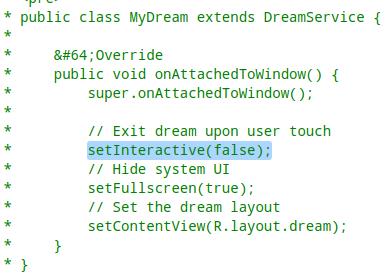屏保的一些知识点
Posted 福尔摩聪
tags:
篇首语:本文由小常识网(cha138.com)小编为大家整理,主要介绍了屏保的一些知识点相关的知识,希望对你有一定的参考价值。
一.屏保的一些配置
1.默认屏保启动时间
frameworks/base/packages/SettingsProvider/res/values/defaults.xml
600000
(正常是配置在这个文件里面的,但是许多项目会在device下面重新写一个defaults.xml文件,类似于overlay,替换掉默认的一些配置,eg:device/msm/common/overlay_screenoff/frameworks/base/packages/SettingsProvider/res/values/defaults.xml)
2.默认屏保类型
frameworks/base/core/res/res/values/config.xml
com.dangbei.screensaver.dynamic/com.dangbei.screensaver.dynamic.DynamicDream
(和默认的启动时间类似,大部分项目也都会在overlay下重新创建一个config.xml,重写一部分配置。 eg:device/msm/common/tv/overlay/frameworks/base/core/res/res/values/config.xml)
二.设置是如何设置屏保相关的
1.获取当前设备内所有类型的屏保
final List<DreamBackend.DreamInfo> infos = mBackend.getDreamInfos();
public List<DreamInfo> getDreamInfos() {
logd("getDreamInfos()");
ComponentName activeDream = getActiveDream();
PackageManager pm = mContext.getPackageManager();
Intent dreamIntent = new Intent(DreamService.SERVICE_INTERFACE);
List<ResolveInfo> resolveInfos = pm.queryIntentServices(dreamIntent,
PackageManager.GET_META_DATA);
List<DreamInfo> dreamInfos = new ArrayList<>(resolveInfos.size());
for (ResolveInfo resolveInfo : resolveInfos) {
if (resolveInfo.serviceInfo == null)
continue;
DreamInfo dreamInfo = new DreamInfo();
dreamInfo.caption = resolveInfo.loadLabel(pm);
dreamInfo.icon = resolveInfo.loadIcon(pm);
dreamInfo.componentName = getDreamComponentName(resolveInfo);
dreamInfo.isActive = dreamInfo.componentName.equals(activeDream);
dreamInfo.settingsComponentName = getSettingsComponentName(pm, resolveInfo);
dreamInfos.add(dreamInfo);
}
Collections.sort(dreamInfos, mComparator);
return dreamInfos;
}
从源码里面可以看出,通过PMS的queryIntentServices方法,获取所有满足action为 "android.service.dreams.DreamService"的resolveInfos 。之后再解析成对应的DreamInfo 。
2.打开对应屏保的预览界面(也可以说是设置界面)
private void setActiveDream(String componentNameString) {
Log.i(TAG, "setActiveDream: componentNameString");
final DreamBackend.DreamInfo dreamInfo = mDreamInfos.get(componentNameString);
if (dreamInfo != null) {
if (dreamInfo.settingsComponentName != null) {
startActivity(new Intent().setComponent(dreamInfo.settingsComponentName));
}
if (!mBackend.isEnabled()) {
mBackend.setEnabled(true);
}
// if (!Objects.equals(mBackend.getActiveDream(), dreamInfo.componentName)) {
// mBackend.setActiveDream(dreamInfo.componentName);
// }
} else {
if (mBackend.isEnabled()) {
mBackend.setActiveDream(null);
mBackend.setEnabled(false);
}
}
}
这里的关键是dreamInfo.settingsComponentName。(后面会有讲)
3.设置屏保启动时间
String SCREEN_OFF_TIMEOUT = “system screen_off_timeout”
private void setDreamTime(int ms) {
Settings.System.putInt(getActivity().getContentResolver(), SCREEN_OFF_TIMEOUT, ms);
}
//设置成永不启动,按道理说应该是将屏保关闭掉:
Settings.Secure.putInt(mContext.getContentResolver(), 0);
但是原生设置里面并不是这么做的,而是将屏保启动时间设置成最大:2147483647
这么做的原因暂时未知。
三.屏保应用该如何做
1.AndroidManifest文件配置
<service android:name=".DynamicDream"
android:exported="true"
android:permission="android.permission.BIND_DREAM_SERVICE"
android:label="@string/app_name">
<meta-data
android:name="android.service.dream"
android:resource="@xml/dynamic_dream"/>
<intent-filter>
<action android:name="android.service.dreams.DreamService" />
<category android:name="android.intent.category.DEFAULT" />
</intent-filter>
</service>
①android:permission=“android.permission.BIND_DREAM_SERVICE”
这个是必须的,在DreamManagerService里面 会有一个如下判断:
private boolean validateDream(ComponentName component) {
if (component == null) return false;
final ServiceInfo serviceInfo = getServiceInfo(component);
if (serviceInfo == null) {
Slog.w(TAG, "Dream " + component + " does not exist");
return false;
} else if (serviceInfo.applicationInfo.targetSdkVersion >= Build.VERSION_CODES.LOLLIPOP
&& !BIND_DREAM_SERVICE.equals(serviceInfo.permission)) {
Slog.w(TAG, "Dream " + component
+ " is not available because its manifest is missing the " + BIND_DREAM_SERVICE
+ " permission on the dream service declaration.");
return false;
}
return true;
}
在获取本设备上所有的屏保应用时,会加上如上判断。如果该类型的屏保没有这个权限,则会被判定成无效屏保,不会被添加到屏保列表里面。
②
这个是必须的,只有加上这个action,才会被搜索到。
public static final String SERVICE_INTERFACE =
"android.service.dreams.DreamService";
public List<DreamInfo> getDreamInfos() {
logd("getDreamInfos()");
ComponentName activeDream = getActiveDream();
PackageManager pm = mContext.getPackageManager();
Intent dreamIntent = new Intent(DreamService.SERVICE_INTERFACE);
List<ResolveInfo> resolveInfos = pm.queryIntentServices(dreamIntent,
PackageManager.GET_META_DATA);
List<DreamInfo> dreamInfos = new ArrayList<>(resolveInfos.size());
for (ResolveInfo resolveInfo : resolveInfos) {
if (resolveInfo.serviceInfo == null)
continue;
DreamInfo dreamInfo = new DreamInfo();
dreamInfo.caption = resolveInfo.loadLabel(pm);
dreamInfo.icon = resolveInfo.loadIcon(pm);
dreamInfo.componentName = getDreamComponentName(resolveInfo);
dreamInfo.isActive = dreamInfo.componentName.equals(activeDream);
dreamInfo.settingsComponentName = getSettingsComponentName(pm, resolveInfo);
dreamInfos.add(dreamInfo);
}
Collections.sort(dreamInfos, mComparator);
return dreamInfos;
}
③ < meta-data >的设置
这个是预览界面相关的。
dynamic_dream.xml:
<?xml version="1.0" encoding="utf-8"?>
<dream xmlns:android="http://schemas.android.com/apk/res/android"
android:settingsActivity="com.dangbei.screensaver.dynamic/.DynamicDreamSettings" />
google建议通过上述方法绑定屏保和屏保预览界面:
这种配置在后续跳转到预览界面时会起作用:
设置是如何跳转到预览界面呢?
private void setActiveDream(String componentNameString) {
Log.i(TAG, "setActiveDream: componentNameString");
final DreamBackend.DreamInfo dreamInfo = mDreamInfos.get(componentNameString);
if (dreamInfo != null) {
if (dreamInfo.settingsComponentName != null) {
startActivity(new Intent().setComponent(dreamInfo.settingsComponentName));
}
if (!mBackend.isEnabled()) {
mBackend.setEnabled(true);
}
// if (!Objects.equals(mBackend.getActiveDream(), dreamInfo.componentName)) {
// mBackend.setActiveDream(dreamInfo.componentName);
// }
} else {
if (mBackend.isEnabled()) {
mBackend.setActiveDream(null);
mBackend.setEnabled(false);
}
}
}
那么这个settingsComponentName是怎么来的呢?
可以从获取所有屏保的函数里面看到这个:
dreamInfo.settingsComponentName = getSettingsComponentName(pm, resolveInfo);
private static ComponentName getSettingsComponentName(PackageManager pm, ResolveInfo resolveInfo) {
if (resolveInfo == null
|| resolveInfo.serviceInfo == null
|| resolveInfo.serviceInfo.metaData == null)
return null;
String cn = null;
XmlResourceParser parser = null;
Exception caughtException = null;
try {
parser = resolveInfo.serviceInfo.loadXmlMetaData(pm, DreamService.DREAM_META_DATA);
if (parser == null) {
Log.w(TAG, "No " + DreamService.DREAM_META_DATA + " meta-data");
return null;
}
Resources res = pm.getResourcesForApplication(resolveInfo.serviceInfo.applicationInfo);
AttributeSet attrs = Xml.asAttributeSet(parser);
int type;
while ((type=parser.next()) != XmlPullParser.END_DOCUMENT
&& type != XmlPullParser.START_TAG) {
}
String nodeName = parser.getName();
if (!"dream".equals(nodeName)) {
Log.w(TAG, "Meta-data does not start with dream tag");
return null;
}
TypedArray sa = res.obtainAttributes(attrs, com.android.internal.R.styleable.Dream);
cn = sa.getString(com.android.internal.R.styleable.Dream_settingsActivity);
sa.recycle();
} catch (PackageManager.NameNotFoundException|IOException|XmlPullParserException e) {
caughtException = e;
} finally {
if (parser != null) parser.close();
}
if (caughtException != null) {
Log.w(TAG, "Error parsing : " + resolveInfo.serviceInfo.packageName, caughtException);
return null;
}
if (cn != null && cn.indexOf('/') < 0) {
cn = resolveInfo.serviceInfo.packageName + "/" + cn;
}
return cn == null ? null : ComponentName.unflattenFromString(cn);
}
从上述函数可以看到,获取屏保的预览界面的ComponentName时,就是通过解析AndroidManifest文件里面的service的属性。其中DREAM_META_DATA = “android.service.dream”;
所以按照google建议的流程做,就是每个屏保service都绑定一个预览界面。这样做的好处就是屏保应用和设置不需要再相互传递消息。
2.继承DreamService

重写onAttachedToWindow(),将屏保界面展示出来。其中有一点需要注意,setInteractive(false)。这个函数里面的参数是需要注意的。
false:按下任何按键都会退出屏保
true:按下返回键退出屏保。
设置成true的好处就是,可以自定义其他按键事件。比如说设置成true之后,我可以按左右键的时候切换屏保资源,按其他键再退出。
原理如下:
@Override
public boolean dispatchKeyEvent(KeyEvent event) {
// TODO: create more flexible version of mInteractive that allows use of KEYCODE_BACK
if (!mInteractive) {
if (mDebug) Slog.v(TAG, "Waking up on keyEvent");
wakeUp();
return true;
} else if (event.getKeyCode() == KeyEvent.KEYCODE_BACK) {
if (mDebug) Slog.v(TAG, "Waking up on back key");
wakeUp();
return true;
}
return mWindow.superDispatchKeyEvent(event);
}
3.将本屏保设置成当前屏保
这个建议在屏保应用本身做,这个是咱们的需求决定的。之前原生的几种屏保,都是只要进入预览界面,就会将屏保设置成系统当前屏保,所以这是可以在设置里面做的。但是咱们这边的需求不太一样,咱们是要先进入到预览界面,点击设成屏保之后才能设置成当前屏保。如果点击返回,那么屏保类型不变。所以建议在屏保应用本身做.
private final IDreamManager mDreamManager;
mDreamManager = IDreamManager.Stub.asInterface(
ServiceManager.getService(DreamService.DREAM_SERVICE));
public void setActiveDream(ComponentName dream) {
logd("setActiveDream(%s)", dream);
if (mDreamManager == null)
return;
try {
ComponentName[] dreams = { dream };
mDreamManager.setDreamComponents(dream == null ? null : dreams);
} catch (RemoteException e) {
Log.w(TAG, "Failed to set active dream to " + dream, e);
}
}
以上是关于屏保的一些知识点的主要内容,如果未能解决你的问题,请参考以下文章